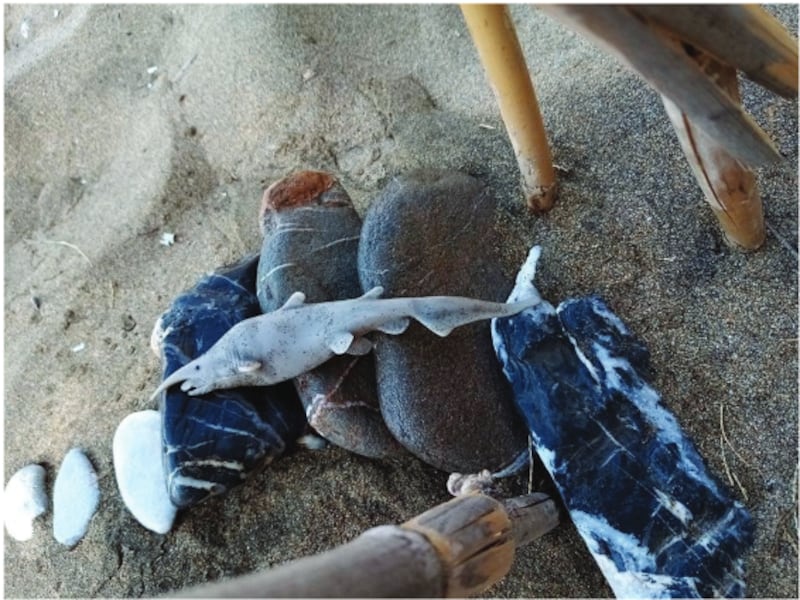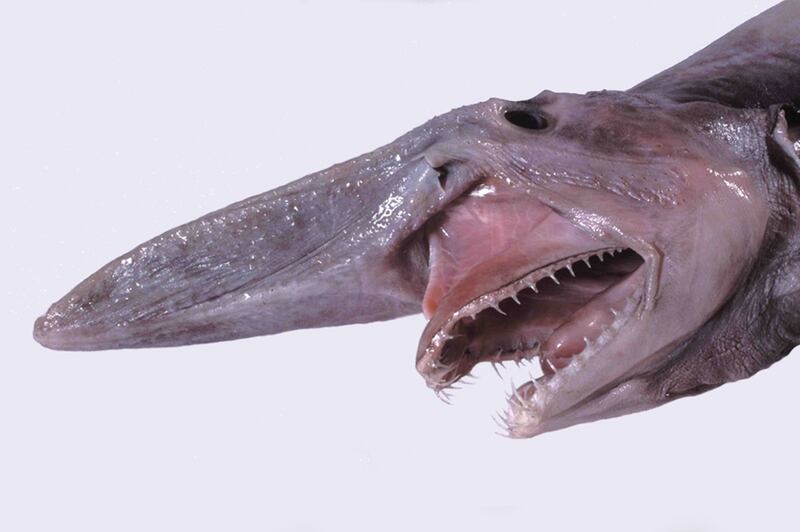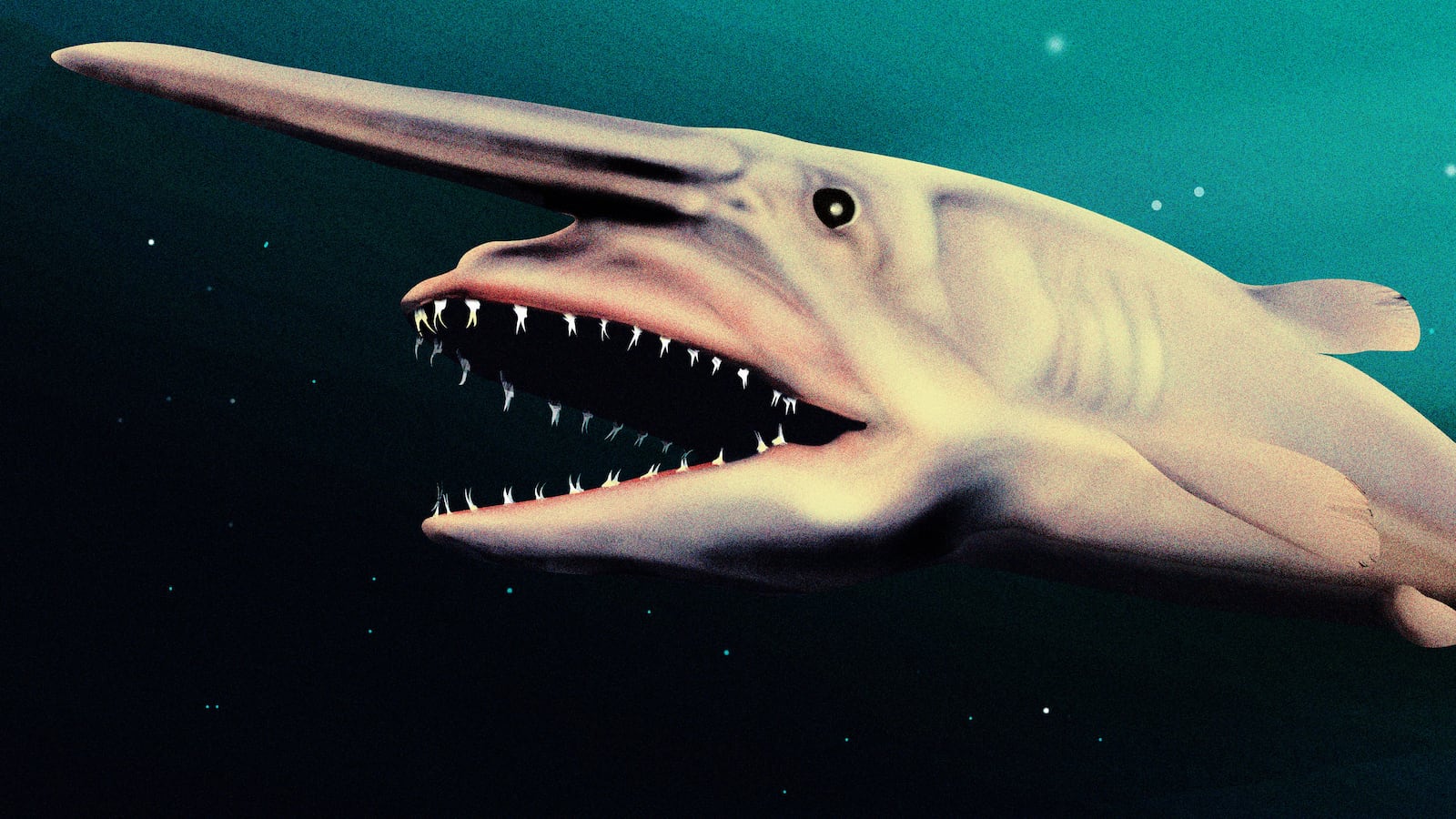Update 3/23: The authors have retracted the original paper.
A controversy is raging within the small but fiercely passionate world of ichthyology (the study of fishes). Depending on who you talk to, either a rare deep-sea shark washed up on the shores of Greece’s Anafi Island in 2020, and marked the first-ever recording of a goblin shark sighting in the Mediterranean Sea; or, some scientists faked the whole discovery using a plastic toy and duped the world with some trickery that’s not much more advanced than a simple social media prank.
The fight stems from a paper published in the journal Mediterranean Marine Science last May, which detailed a goblin shark specimen that a citizen scientist stumbled upon while walking along the Greek beach. The paper, authored by three marine biologists from three different universities (two in Greece and one in Scotland), included a photo taken by a citizen scientist depicting an unusually small, gray-blue and remarkably well-preserved goblin shark. It was an incredible finding—the kind scientists pray might fall into their lap during the course of their careers.
And for some, it was too good to be true. The photo rang alarm bells for some marine scientists almost immediately after it was published.
“It looks like a very common toy,” Vicky Vásquez, a shark expert at the Pacific Shark Research Center in Monterey, California, told The Daily Beast. In the ensuing kerfuffle, Twitter sleuths pointed out that the shark in the image bore an uncanny resemblance to a goblin shark model manufactured by Italian toymakers DeAgostini, right down to the seam on the side of the mouth.
Marine biologists across the globe have been pushed into picking sides—some who are highly skeptical the goblin fish specimen is the real deal, and some who still maintain that the specimen could be genuine. The authors stand by their work, going as far as to write an extra defense of the paper, published last week, that pushes back aggressively on the idea they published a toy model in a peer-reviewed journal and passed it off as scientific evidence.
The authors did not respond to requests for an interview. Hours after this story was first published, The Daily Beast was informed the paper had been retracted, which the authors confirmed over email the following day. “Even though we have every reason to assume that the finding was authentic (several Mediterranean shark experts and [two] anonymous peer reviewers accepted and supported publication of this paper!), other colleagues caused a completely unethical controversy and claimed that the specimen was a discarded plastic figurine,” said co-author Frithjof Kuepper from the University of Aberdeen in Scotland. “In order to avoid further damage and given that the specimen had not been conserved by the citizen scientist in Anafi (Papadakis), we decided to retract the article.”
The original paper is no longer available to read online. The journal did not respond to requests for comment.
It is hard to believe a single study—and really, a single photograph—has elicited so much sniping in the last year between scientists, a community that’s often portrayed as level-headed, sometimes to the point of dullness. But the stakes of the new fight are high, in part because of the nature of the goblin shark itself, and in part because the age of disinformation has spurred researchers into a more combative state to scrub away false information as fast as possible, before it has a chance to take hold.
Rare as Gold
Goblin sharks, the common name for Mitsukurina owstoni, are a reclusive and somewhat mysterious species. They make their home in the deep ocean, as far down as 1,300 meters (4,300 feet), where light is scarce and the pressure is strong enough to snap human bones. There, they mostly feed on fish, squids and crustaceans, which they snatch up with their razor-sharp retractable jaws.
Fewer than fifty goblin sharks have been scientifically documented, though they occasionally turn up as bycatch in commercial fishing nets. Their range includes the Atlantic, Pacific and Indian oceans, as well as the Gulf of Mexico. But scientists really have no idea where they breed or how long they live.
The new study reports that the goblin shark photo was taken on August 25, 2020, “found by a citizen on Klisidi beach of Anafi Island,” credited to Giannis Papadakis. The paper does not specify who Papadakis is, or whether he is the one who first found the specimen on the beach. (As mentioned, the authors did not respond to questions from The Daily Beast.)

A photo of the goblin shark in question, published in Mediterranean Marine Science in May 2022.
Giannis PapadakisNevertheless, finding a genuine juvenile goblin shark in the Mediterranean would signal a significant range extension for these benthic behemoths and could even provide tantalizing clues as to where they breed. That is, if the find is real.
Jürgen Pollerspöck has doubts.
An independent shark researcher based in Germany, Pollerspöck has seen a plethora of deceased sharks over the course of his career. He came across the paper on the Anafi Island goblin shark last July, and added the article to an online shark, ray and chimera research database he helps curate. He more or less forgot about it until a couple of months later, when he finally had time to sit down and read it.
Something about the discovery struck Pollerspöck as… fishy. “After reading the article in detail, I had doubts about the record,” he told The Daily Beast in an email.

Head of a goblin shark on display at a muesum in Australia.
Dianne Bray / Museum VictoriaPollerspöck, along with three other shark experts, decided to write into the journal detailing their concerns. Mediterranean Marine Science published their comments last week.
In those comments, the researchers point out that the shark-in-question only appeared to have four gill slits, even though goblin sharks have five. Its jaw was fully protruded in hunting position, rather than relaxed, despite lacking visible teeth. And its nose had a weird downward droop unlike most goblin sharks' characteristically stiff, straight snout.
But the biggest red flag they found was that the picture lacked any measurement scale. The authors only vaguely listed the specimen as “not exceed[ing] 80 cm (2.5 feet) in total length,” which would make it the smallest goblin shark on record. Goblin sharks regularly grow to lengths of 2.5 meters (8.5 feet).
“Fishing in the Mediterranean has a long tradition,” Pollerspöck said. “It would be a surprise if such a large animal had remained undiscovered until today.”
The original authors didn’t relent in the face of Pollerspöck and his co-author’s comments—instead, they doubled down, writing a rebuttal (also published in the same journal) that defended the findings. The authors provided new clarifications meant to address some of the issues, including a more precise measurement of 17-20 cm (just over half a foot) long, and an assertion that the specimen was unusually small because it was embryonic. They chalked the weird nose and teeth up to individual variation, and blamed the extended jaw on stress before death. The gill slits, they insisted, were all there if you zoomed in.
“The fact that they had a rebuttal is what really, really got me hooked,” said Vásquez. “I thought it was just gonna get very quickly retracted.” In most cases of academic fraud or mistaken identity, the journal pulls the questionable paper soon after well-qualified experts raise concerns. This is what happened in a famous case of fish fraud from the late 1990s, when someone tried to pass a poorly photoshopped picture of a coelacanth off as a new species. In this case, however, Mediterranean Marine Science let the paper stand.
Others were also critical of the rebuttal, especially that it was an embryonic specimen. “I don’t think that argument holds a lot of water,” Chip Cotton, a marine biologist at SUNY Cobleskill in New York who specializes in deepwater sharks, told The Daily Beast. He explained that it’s rare for an embryonic shark to wash up on beaches intact; they’re much more likely to get eaten by hungry marine scavengers, especially in the deep sea. Cotton suspects that such a tender morsel would almost certainly be gobbled up before it came anywhere near the shoreline. “The odds are just astronomical,” he told the Daily Beast.
When Cotton first saw the photo, he suspected it might be a cat shark with a fake snout photoshopped onto its face. However, he’s since come around to thinking that the specimen is probably a toy spruced up with some color editing. Likewise, Vásquez believes that the specimen in the photo is way too rigid to be a real deep-shark, whose skulls stay hard but whose bodies and fins tend to become flabby and flaccid on land.
Playing Defense
Not everyone is convinced the shark is plastic. “When I first looked at it, I thought it was odd. But the more I look at it, the more I think it’s an actual specimen,” Glenn Parsons, a marine biologist at the University of Mississippi who helped describe the first documented goblin shark in the Gulf of Mexico two decades ago, told The Daily Beast. He cites the fine white edging on the shark’s fins, which is characteristic of late-term embryos in many shark species.
However, if the shark is a model, those white tips could be the result of plastic degradation and sun bleaching, according to reporting by Gizmodo. Still, it’s hard to tell from a single mid-quality photo. “You really can’t prove it unless you have it in your hands,” Parsons told the Daily Beast.
Perhaps the biggest worry among scientists isn’t really the fact that the photograph itself might be fake, but the consequences downstream. Phony range extension data might seem harmless, but it can have sweeping consequences. “It can certainly throw off the science,” biogeographer Alexa Fredston of the University of California, Santa Cruz told The Daily Beast. This can influence everything from government funding to ecological models to how (or whether) conservation policy gets enacted.
Fredston also worries that the dust-up could scare researchers off of crowd-sourced data. Thousands of species have been successfully documented or rediscovered thanks to the efforts of citizen scientists, while peer-reviewed mix-ups involving such data remain rare, she said. “I really hope it doesn’t prevent people from engaging with citizen science.”
But even if the shark is fake (and if the paper really was retracted, that seems to be a bigger likelihood), that doesn’t necessarily mean that it’s a case of intentional fraud. Vásquez and Cotton believe it’s possible that the authors simply got overexcited about what would have honestly been a pretty cool discovery, and didn’t do their due diligence in following up. Or, they said, it could be that, as early-career scientists, they felt enormous pressure to publish something in an academic journal, like a great white that has to keep moving to survive. Pollerspöck himself assumes good intentions—if sloppy science—on the part of the original paper’s authors until proven otherwise.








